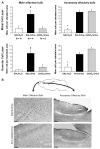Destruction of the main olfactory epithelium reduces female sexual behavior and olfactory investigation in female mice
- PMID: 16484502
- PMCID: PMC2263131
- DOI: 10.1093/chemse/bjj035
Destruction of the main olfactory epithelium reduces female sexual behavior and olfactory investigation in female mice
Abstract
We studied the contribution of the main olfactory system to mate recognition and sexual behavior in female mice. Female mice received an intranasal irrigation of either a zinc sulfate (ZnSO4) solution to destroy the main olfactory epithelium (MOE) or saline (SAL) to serve as control. ZnSO4-treated female mice were no longer able to reliably distinguish between volatile as well as nonvolatile odors from an intact versus a castrated male. Furthermore, sexual behavior in mating tests with a sexually experienced male was significantly reduced in ZnSO4-treated female mice. Vomeronasal function did not seem to be affected by ZnSO4 treatment: nasal application of male urine induced similar levels of Fos protein in the mitral and granule cells of the accessory olfactory bulb (AOB) of ZnSO4 as well as SAL-treated female mice. Likewise, soybean agglutinin staining, which stains the axons of vomeronasal neurons projecting to the glomerular layer of the AOB was similar in ZnSO4-treated female mice compared to SAL-treated female mice. By contrast, a significant reduction of Fos in the main olfactory bulb was observed in ZnSO4-treated females in comparison to SAL-treated animals, confirming a substantial destruction of the MOE. These results show that the MOE is primarily involved in the detection and processing of odors that are used to localize and identify the sex and endocrine status of conspecifics. By contrast, both the main and accessory olfactory systems contribute to female sexual receptivity in female mice.
Figures




Similar articles
-
Sexual experience does not compensate for the disruptive effects of zinc sulfate--lesioning of the main olfactory epithelium on sexual behavior in male mice.Chem Senses. 2006 Oct;31(8):753-62. doi: 10.1093/chemse/bjl018. Epub 2006 Aug 10. Chem Senses. 2006. PMID: 16901952
-
Accessory olfactory bulb function is modulated by input from the main olfactory epithelium.Eur J Neurosci. 2010 Mar;31(6):1108-16. doi: 10.1111/j.1460-9568.2010.07141.x. Epub 2010 Mar 8. Eur J Neurosci. 2010. PMID: 20377623 Free PMC article.
-
Sexually dimorphic activation of the accessory, but not the main, olfactory bulb in mice by urinary volatiles.Eur J Neurosci. 2007 Jul;26(2):463-75. doi: 10.1111/j.1460-9568.2007.05651.x. Epub 2007 Jul 10. Eur J Neurosci. 2007. PMID: 17623023 Free PMC article.
-
Sex differences in main olfactory system pathways involved in psychosexual function.Genes Brain Behav. 2020 Feb;19(2):e12618. doi: 10.1111/gbb.12618. Epub 2019 Nov 4. Genes Brain Behav. 2020. PMID: 31634411 Review.
-
Odor-guided behavior in mammals.Experientia. 1986 Mar 15;42(3):257-71. doi: 10.1007/BF01942506. Experientia. 1986. PMID: 3514263 Review.
Cited by
-
Lesions that functionally disconnect the anterior and posterodorsal sub-regions of the medial amygdala eliminate opposite-sex odor preference in male Syrian hamsters (Mesocricetus auratus).Neuroscience. 2010 Feb 17;165(4):1052-62. doi: 10.1016/j.neuroscience.2009.11.024. Epub 2009 Nov 18. Neuroscience. 2010. PMID: 19931356 Free PMC article.
-
Neural control of female sexual behaviors.Horm Behav. 2023 May;151:105339. doi: 10.1016/j.yhbeh.2023.105339. Epub 2023 Mar 4. Horm Behav. 2023. PMID: 36878049 Free PMC article. Review.
-
The interplay between reproductive social stimuli and adult olfactory bulb neurogenesis.Neural Plast. 2014;2014:497657. doi: 10.1155/2014/497657. Epub 2014 Jul 22. Neural Plast. 2014. PMID: 25140258 Free PMC article. Review.
-
Neural Circuit Mechanisms of Social Behavior.Neuron. 2018 Apr 4;98(1):16-30. doi: 10.1016/j.neuron.2018.02.026. Neuron. 2018. PMID: 29621486 Free PMC article. Review.
-
Role for estradiol in female-typical brain and behavioral sexual differentiation.Front Neuroendocrinol. 2008 Jan;29(1):1-16. doi: 10.1016/j.yfrne.2007.06.001. Epub 2007 Jul 26. Front Neuroendocrinol. 2008. PMID: 17720235 Free PMC article. Review.
References
-
- Baum MJ, Keverne EB. Sex difference in attraction thresholds for volatile odors from male and estrous female mouse urine. Horm Behav. 2002;41:213–219. - PubMed
-
- Brown RE. Mammalian social odors. Adv Study Behav. 1979;10:107–161.
-
- Bruce HM. An exteroceptive block to pregnancy in the mouse. Nature. 1959;184:105. - PubMed
-
- Edwards DA, Burge KG. Olfactory control of sexual behavior of male and female mice. Physiol Behav. 1973;11:867–872. - PubMed

